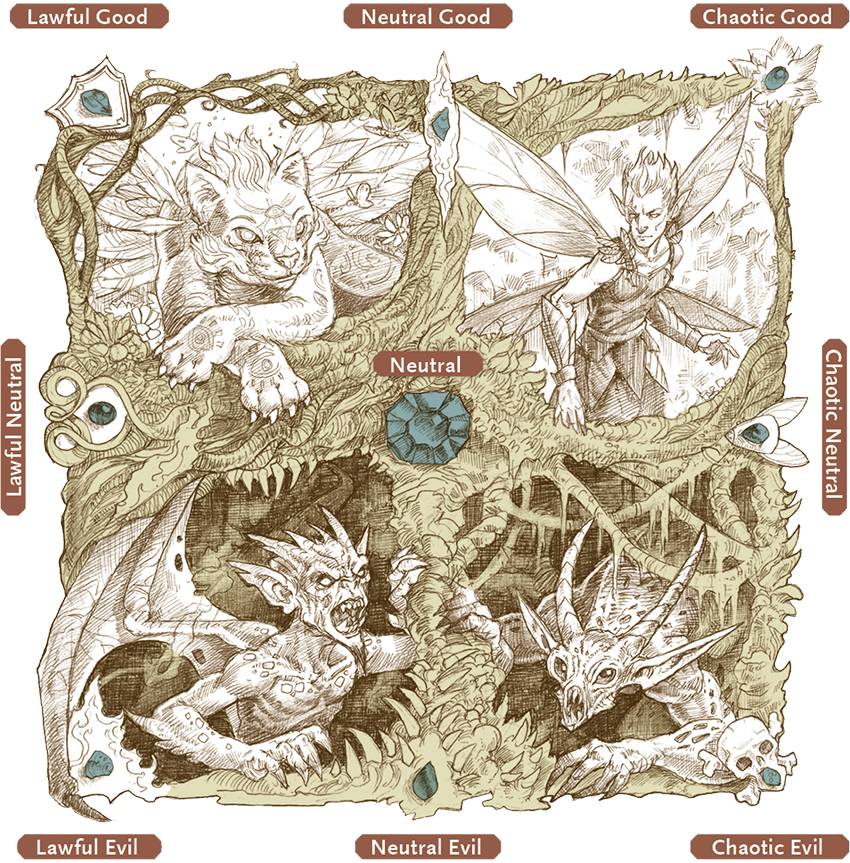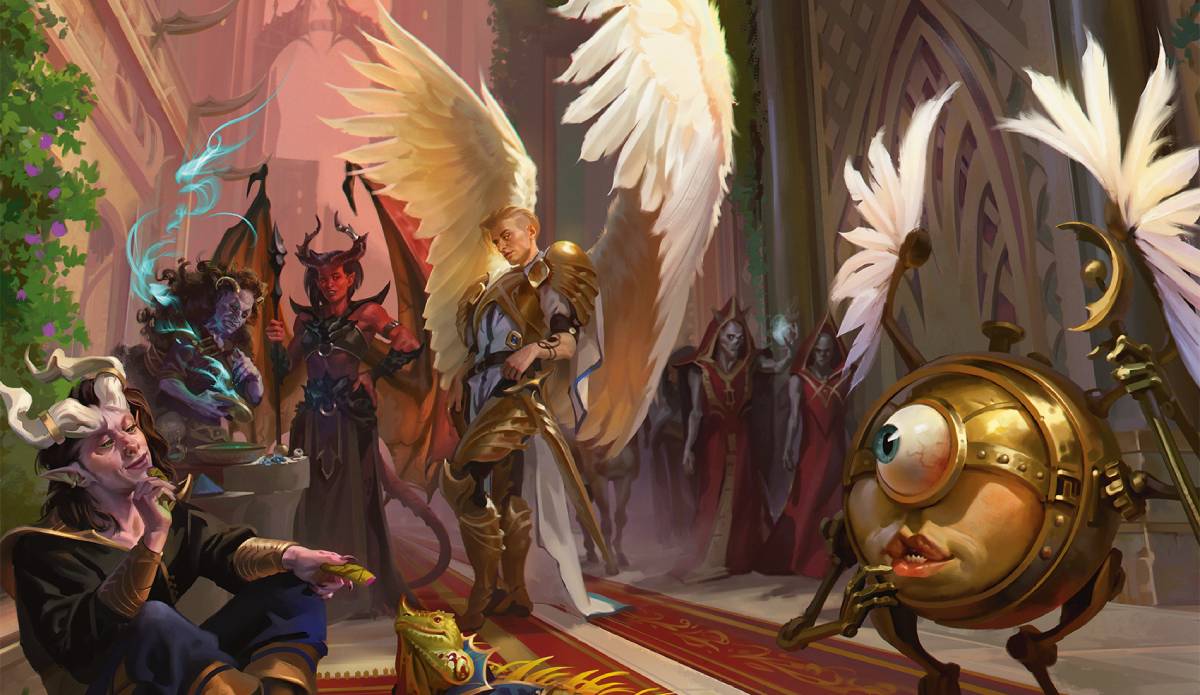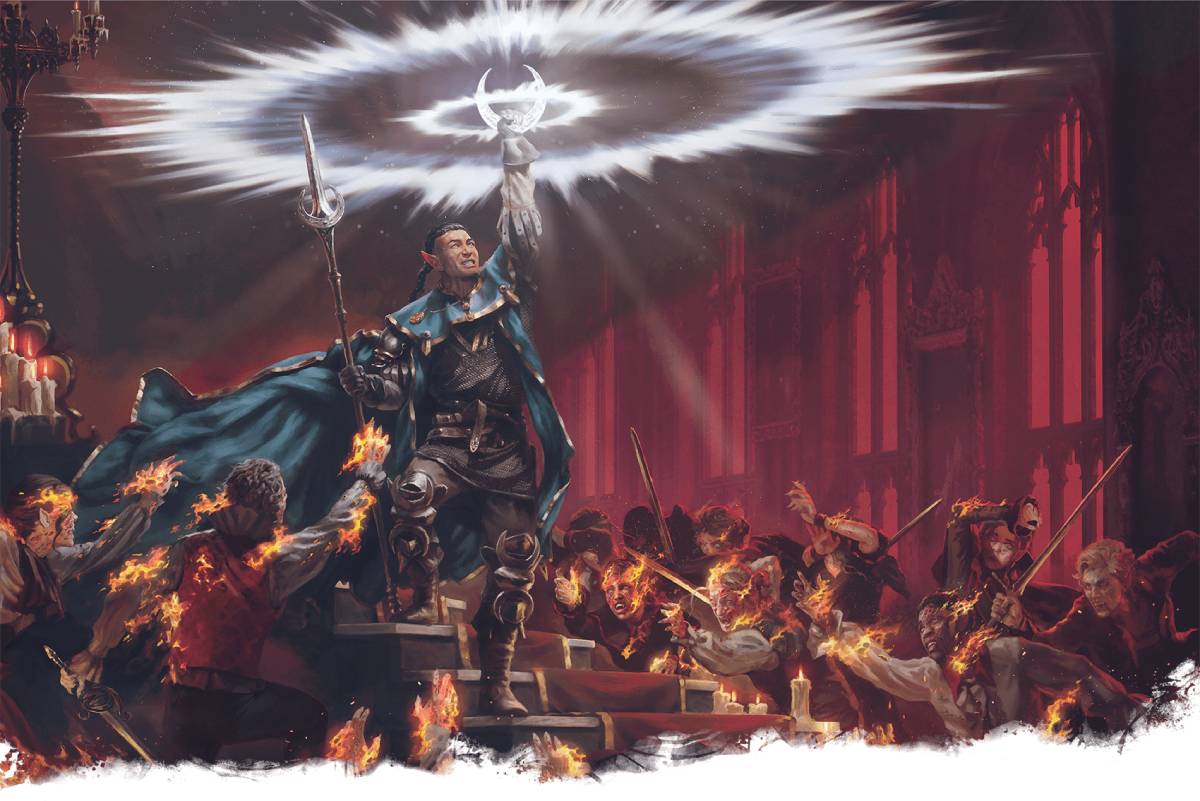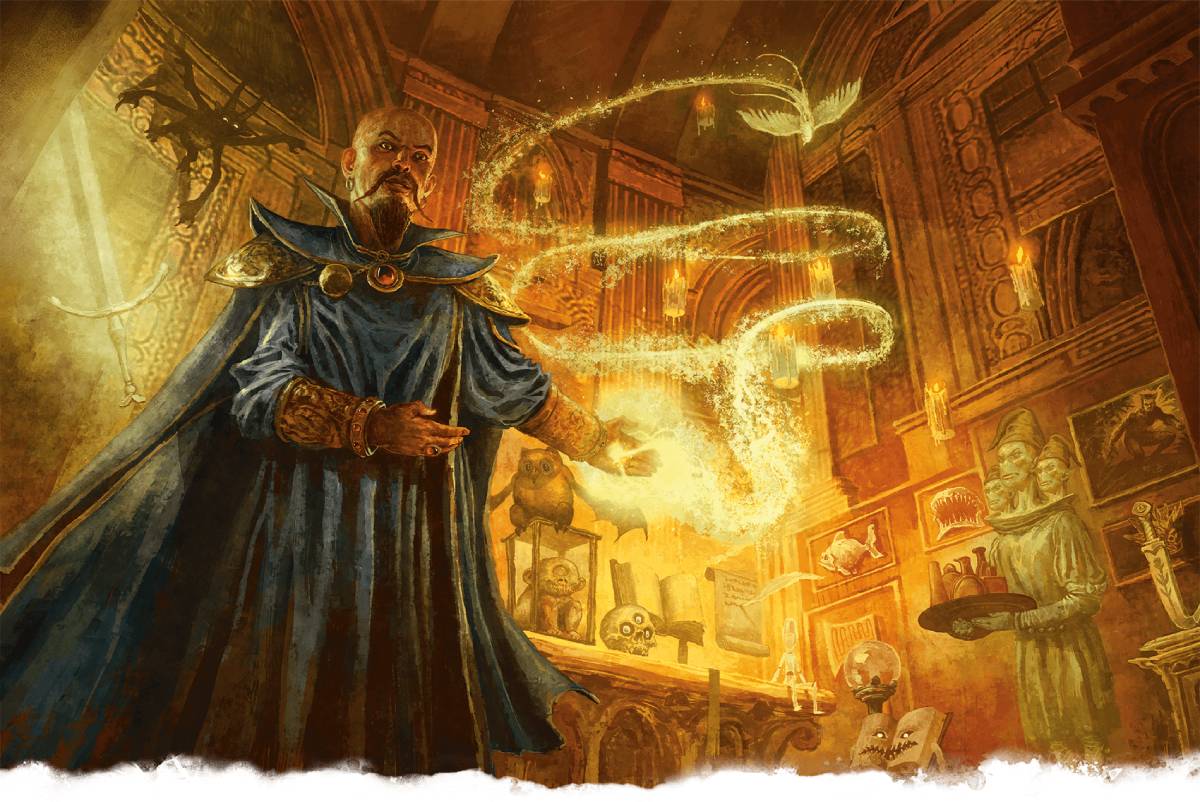Alignment in Dungeons & Dragons is used to define a creature’s moral and ethical perspective. This foundational concept has been part of the game’s DNA since D&D’s earliest days, and it is still an integral part of the 2024 Core Rulebooks. In the 2024 Player’s Handbook, the iconic D&D alignment chart is a roleplaying tool used in character creation, while the 2024 Dungeon Master’s Guide helps DMs use alignment to run monsters and explains how this fundamental concept manifests itself in D&D’s cosmology.
Let’s explore how alignment fits into the 2024 core rules and how you can use it as a tool to serve you and your game!
- What is Alignment in D&D?
- Using Alignment When Creating Characters
- Morality for Player Characters
- Using Alignment as a Dungeon Master
- What Are the Nine Alignments in D&D?
What is Alignment in D&D?
Alignment in D&D broadly describes a character’s ethical attitudes and ideals based on two key factors: their morality and their tendencies towards order. The intersection of these two concepts creates the D&D alignment chart, a set of nine different alignments that reflect typical behaviors across the spectrum of good and evil, and law and chaos.

Using Alignment When Creating Characters
When creating a new character in D&D, the choice of your character’s alignment is a decision you make after you’ve selected their class, origin, and ability scores. While your alignment doesn’t come with any specific mechanical effects, it helps you combine the elements of your character into their personality for you to roleplay.
Actions Dictate Alignment
When selecting an alignment for your character, don’t consider it a restriction that defines what your character can or can’t do. Instead, imagine it as a description of their actions and how they approach the world.
So, if you’re playing a Fighter with the Guard background who adheres to the regimens and structure of their old life, you might consider them lawful. But if they left that work because it was too restrictive and they yearned to roam free, they might be chaotic instead.
Alignment Can Change
Character alignments can change over time. For example, in Dungeons & Dragons: Honor Among Thieves, Edgin's backstory begins with him following a strict code as a member of the benevolent Harpers organization, meaning he’d have a Lawful Good alignment.
Eventually, he rejected that code for personal profit and later survival, so you might view him as Chaotic Neutral. By the end of the film, and in his official Thieves’ Gallery stat block, he’s listed as having a Chaotic Good alignment.
Morality for Player Characters

D&D is a game of heroic fantasy roleplaying. As such, the default assumption is that player characters will have a good or neutral alignment. The 2024 Player’s Handbook suggests that if, as a player, you want to be an evil-aligned character, you should discuss it with your DM first.
Good and Evil Can Cooperate
With DM permission, you can bring an evil character into a game. When playing an evil-aligned character in a party of good-aligned characters, it’s important to remember that despite having different motives, you, as players, should share the same goal while playing. Your intent in making an evil character shouldn’t be to consistently disrupt and work against your group’s ability to mutually enjoy the game.
Good and evil characters can cooperate and frequently do in all kinds of stories. A Chaotic Good vampire hunter might work with a Lawful Evil vampire to destroy a common enemy when it serves their mutual interest. A swamp-dwelling Neutral Evil Ogre might begrudgingly join a Neutral Good donkey on a quest, as long as it gets the disruptive fairytale creatures out of his home. And who knows, that ogre’s actions in the face of strife may reveal that he now has a Chaotic Good alignment.
There are ways to make conflicting moralities work well together and form interesting narratives, but it does require the players to buy into that shared story.
Using Alignment as a Dungeon Master
As a Dungeon Master, alignment can be a useful tool for getting into the mindset of your creatures. When you’re running an NPC based on the information in their stat block, their alignment can prompt you on their starting attitude towards the party and how to roleplay them during your sessions.
When you’re tracking a lot of different characters, it can be helpful to glance at a stat block and decide whether you should roleplay a creature as a scheming trickster or as a kindhearted soul who genuinely just wants to help out the players.
Similarly, understanding alignment can serve as a useful shorthand when creating your own NPCs. For instance, is your villain Lawful Evil, pursuing their ambitions within the structured hierarchy of a kingdom? Or are they Chaotic Evil, a vengeful outsider leading an army determined to raze the kingdom’s capital? Is a potential ally Lawful Neutral and will only give aid if the party makes a compelling case? Or are they a Lawful Good creature who will support any worthy cause?
Like with your players’ characters, though, an individual's actions can stray from the tenets of their alignment, and their alignment can change! If you initially envision someone as a Lawful Evil character and the players topple their plans, they might later return seeking revenge as a Chaotic Evil character. Or, in a more extreme case, a character who was Lawful Evil earlier in the campaign might have a change of heart and shift to Neutral or even Chaotic Good if the characters’ actions make them see the error of their ways.
What Are the Nine Alignments in D&D?
Let’s take a look at each of the alignments in the D&D alignment chart and what they mean for a character.
Lawful Good

A Lawful Good character feels a duty to do what society considers to be the right thing. They tend to follow rules while also having compassion and concern for their fellow beings. A Lawful Good character might be beholden to the laws of the land, but they may instead follow a strict moral code imparted to them by their organization.
Xenk Yendar in Dungeons & Dragons: Honor Among Thieves is a Lawful Good character. He lives according to his Paladin’s oath to protect the innocent and vanquish evil. He temporarily works with the more roguish protagonists of the film, while always urging them to walk a more valiant path such as his own.
Neutral Good
A Neutral Good character does the best they can, working within the rules when they can but not feeling restricted by them. They still care about helping others, and will generally still find noble causes appealing and necessary.
Another character from Dungeons & Dragons: Honor Among Thieves, Doric, is an example of a Neutral Good character. She doesn’t trust humans because of her past as a tiefling and isn’t particularly concerned with their laws, especially the Lord of Neverwinter’s. But she cares deeply about the Emerald Enclave and is willing to join Edgin’s party and their quest to help protect it.
Chaotic Good
A Chaotic Good character lets their conscience be their guide, fighting injustice and protecting others with little regard for outside expectations. A Chaotic Good character might frequently and excitedly commit crimes to serve what they see as the greater good. Characters leading a rebellion against totalitarian or tyrannical leaders are usually considered Chaotic Good.
Robin Hood is a classic example of a Chaotic Good character. In most Robin Hood stories, Robin and his Merry Men steal from the corrupt leaders of Nottingham and return their takings to the suffering people of the town.
Lawful Neutral
A Lawful Neutral character follows their laws or traditions without regard for inherent morality. For a Lawful Neutral creature, adherence to the rules is more important than the demands of those in need or the temptations of evil.
At the start of the Baldur’s Gate 3, Lae’zel is a Lawful Neutral character. She is devoted fully to the tenets of Githyanki society and the requirements of her queen. While she might be perceived as cruel to other characters, she’s simply following the ideals of her people.
Neutral

Neutral characters have no particular alignment towards good or evil, nor are they ruled by chaos or order. Neutral characters are pragmatic and will work towards whatever seems best at the time. Characters who serve as impartial observers tend to be Neutral. Similarly, characters whose main focus is on balance or preserving the natural order, with no specific emphasis on protecting anyone or pursuing selfish gain, are considered Neutral.
The archmage Mordenkainen is an example of a Neutral character. He is the founder and leader of the Circle of Eight, which he created to uphold his philosophy of balance across the multiverse.
Chaotic Neutral
A Chaotic Neutral character prizes their freedom above just about everything else. Their motivations are not cruel, but they’re not particularly interested in kindness either. Characters who are Chaotic Neutral are often described as “moving where the wind takes them.” Rakish scoundrels, roving gamblers, and a few anti-heroes would fall under this banner.
Returning to Baldur’s Gate 3, Astarion begins the game as a Chaotic Neutral character. When he’s first encountered in the game, he’s free for the first time in centuries. His primary drive is to remain free, and he supports decisions that serve that goal. He can be pushed towards good or evil based on choices you make as a player, but the initial cobblestones of either path are paved with his desire to protect and empower himself.
Lawful Evil

Lawful Evil characters empower themselves by using rules, laws, and binding contracts. Examples of Lawful Evil creatures are dictators who impose tyrannical laws or cult leaders who force restrictive tenets on their followers.
Devils, the quintessential inhabitants of the Nine Hells, are often Lawful Evil. They have defined hierarchies and amass power through complicated contracts and cunning deals.
Neutral Evil
Neutral Evil characters pursue their own desires and ambitions without caring at all for the harm it might cause others. They think nothing of putting a whole population of people in danger if it gets them the things they want, such as wealth or power.
Acererak, the infamous lich and architect of deadly tombs, is an example of a Neutral Evil character. He operates without regard for law or chaos, focusing solely on his relentless pursuit of power and immortality. He traps adventurers in his dungeons for his own gain and is entirely unbound by allegiance to any higher principle or authority beyond his ambitions.
Chaotic Evil
Characters that are Chaotic Evil harm others without hesitation and may even go out of their way to do so. They might do this out of bloodlust, out of hatred, or just a general desire to watch the world burn. Characters who kill with reckless abandon or spite tend to be Chaotic Evil.
Demons in D&D are Chaotic Evil engines of destruction, originating from the multiversal embodiment of all things perverse and gruesome—the Abyss. Demons follow no rules or hierarchy, opting instead for sowing chaos in every form. Outside of the D&D universe, the Joker or Mr. Hyde serve as strong examples of Chaotic Evil villains.
Aligned For You
Like your character’s class, species, and background, their alignment is a piece of the overall puzzle that makes up who they are and how they react to situations.
Alignment enables you to know how a character interacts with the morality of their world and how likely they are to follow (or completely ignore) the rules set before them. While a character’s alignment can change and isn’t a restrictive definition of your character, it acts as a guiding light for their ethical attitudes and ideals.

Riley Silverman (@rileyjsilverman) is a contributing writer to D&D Beyond, Nerdist, and SYFY Wire. She DMs the Theros-set Dice Ex Machina for the Saving Throw Show, and has been a player on the Wizards of the Coast-sponsored The Broken Pact. Riley also played as Braga in the official tabletop adaptation of the Rat Queens comic for HyperRPG, and currently plays as The Doctor on the Doctor Who RPG podcast The Game of Rassilon. She currently lives in Los Angeles.








-
View User Profile
-
Send Message
Posted Dec 9, 2024> Similarly, characters whose main focus is on balance or preserving the natural order
In my opinion, "the natural order" should depend on *their perception*. Mordenkainen concern about the balance of good and evil in the Multiverse at large, but for elves who have never seen outside, every detail about their home forest should be "the natural order" for them. Maybe for a human child in Waterdeep, their favorite blanket could be part of it.
-
View User Profile
-
Send Message
Posted Dec 10, 2024Pretty good article tbh
-
View User Profile
-
Send Message
Posted Dec 10, 2024Aren’t sprites NG?
-
View User Profile
-
Send Message
Posted Dec 10, 2024we got that Shrek reference in there lets go
-
View User Profile
-
Send Message
Posted Dec 11, 2024-
View User Profile
-
Send Message
Posted Dec 11, 2024James Bond: Paladin or Cavalier?
Thoughts?
-
View User Profile
-
Send Message
Posted Dec 11, 2024-
View User Profile
-
Send Message
Posted Dec 12, 2024Contrary to this article's title, I don't feel like it makes any real attempt to "break down" alignment in D&D. What is Good? Or Evil? Or Lawful or Chaotic? Neutral characters include those "whose main focus is on balance or preserving the natural order", which sure sounds like the opposite of chaos to me! And if Chaotic Neutral is about prizing your freedom above "just about everything else", how is Neutral Evil about "pursuing your own desires and ambitions" without being chaotic? Its example character, Acererak, is described as "entirely unbound by allegiance to any higher principle or authority", which could not sound any more distant from Lawful! (obviously a dozen of you are ready to tell me that "what chaotic actually means is" or "well if you'd just read the cleric quintet it says" but you are missing my point which is that this article purporting to break down alignment does not do that!)
-
View User Profile
-
Send Message
Posted Dec 12, 2024Yeah... this fails pretty hard. Probably should have talked to a philosophy major or at least someone minoring in it. This article fails to explain what good, or evil is while also failing to even consider the implications of creating a system of objective rather than subjective morality.
-
View User Profile
-
Send Message
Posted Dec 12, 2024Correction: Devils are not often Lawful Evil. They are always Lawful Evil. That is what defines them. They wake up every morning wondering what evil things they can do within the bounds of law to make the multiverse more lawful and more evil. I know it's hard to imagine that creatures could exist that don't have variable alignments like us, because we're humanoids in real life. But it's very important to understand that creatures of other planes have fixed alignments. A devil with any other alignment other than Lawful Evil would be an exception so universe-shattering that there would be legends about it ever after.
-
View User Profile
-
Send Message
Posted Dec 12, 2024can you imagine taking psychology in high school or college and at the start of the first lesson, they just put a dnd alignment chart on the ******* projector
-
View User Profile
-
Send Message
Posted Dec 13, 2024I personally find it rather irksome that the names for the alignments are lawful, chaotic, good, and evil. Most people will see good and evil and believe it is about objective good and evil in the universe. I have never agreed with that view and feel that good and evil are better explained as selflessness versus selfishness. Thus simply, a good character will always be willing to put the needs of others first before their own needs while and evil character will always put their own needs first before anyone else. A neutral character on the good versus evil spectrum is equally willing to be selfless or selfish depending on the circumstances they find themselves in. It is harder for me to describe how I see law and chaos, but the best way I can describe it is collectivist versus individualist. In this sense a lawful person believes that the needs of the many come first before the needs of the few while a chaotic person believes that the needs of the many should not impede the needs of the few.
-
View User Profile
-
Send Message
Posted Dec 13, 2024I agree with your definitions of "good" and "evil" in D&D. Obviously, a lot of people on Earth have very definite views on what good and evil mean, but that doesn't necessarily translate well to an RPG character's values and actions. As for Law and Chaos, I've never thought about it the way you laid it out. It's definitely worth considering. I always thought more of the L/C axis as how closely you adhere to some kind of guideline, whether it's internal or external. Batman is definitely Lawful, despite the fact that he technically operates illegally (comic book vigilante acceptance aside).
-
View User Profile
-
Send Message
Posted Dec 13, 2024Astarion is chaotic-neutral? Is it official?
Because he's Neutral Evil, at least he was in a few official cards.
I could give many examples of him being a perfect example of Neutral Evil in Act 1.
The craving for freedom and power (including for fun), which he wants by any means necessary including causing damage without caring about anyone - this is never chaotic-neutral.
But I think I'll just go with the words of his author Stephen Rooney.
Stephen Rooney | Idle Insights | Idle Champions | D&D
The darker sides of humanity are a perfect match for evil. Just because he's funny and charming doesn't cancel out his dark side.
Is there no male companion with evil alignment in Baldurs Gate 3 at all?
Anyway, I wonder if this is the author's intrapretation of the article or if it's already official information
-
View User Profile
-
Send Message
Posted Dec 13, 2024Astarion chaotic neutral? He has always been neutral evil, like any vampire spawn.
-
View User Profile
-
Send Message
Posted Dec 13, 2024I ended up adopting that stance as it always bothered me that in DND people would say that an evil aligned character is evil incarnate who only exists to cause suffering in the world. In fact, DND over the years has moved away from that very idea with new editions by changing spells like detect good and evil to no longer identify good and evil aligned creatures and to instead find creatures that originate from the upper and lower planes.
When it comes to lawful versus chaotic, it took me a while to arrive at my view on that. The simple explanation that a lawful character follows a code just doesn't work for me. Even a chaotic character can have a personal code that they follow. And this viewpoint always caused issues with the lawful evil alignment where the vast majority of people that describe such an alignment is one who bends their lawful nature to benefit themselves. But one can not have a lawful nature if they are willing to bend it to benefit themselves as that is against the very nature of lawful. The result I arrived at came from studying Mechanus, the plane of law itself. Everything in Mechanus operates towards the ultimate goal of order. This is best exemplified by everything in Mechanus being describes as a gear that is part of a larger machine. It suddenly became clear to me that the very essense of law in DND is working towards the collective whole. With this in mind, chaos becomes easy to define as willing to go against the collective. With this in mind, it leads to the interpretation of the alignments being as follows:
Lawful Good - believes in a collective cause that selflessly works towards the betterment of others
Lawful Evil - believes in a collective cause that seeks to benefit the collective no matter the cost to others
Chaotic Good - believes any action is permissible if it helps those who need it most
Chaotic Evil - believes any action is permissible to benefit themselves
-
View User Profile
-
Send Message
Posted Dec 13, 2024I've had to bite my tongue a few times, just not worth the hassle, in real life because someone would get preachy about what it means to be lawful while ignoring their own hate of "regulations" and governments... Never mind the whole mess of what some people consider good or evil.
-
View User Profile
-
Send Message
Posted Dec 13, 2024Exactly this. this is how I've been playing it for years now, and the confusion and poorly considered titles are why my current group of newbies haven't even <i>seen</i> the table.
-
View User Profile
-
Send Message
Posted Dec 13, 2024Over-complicating morality here, Altruism is DnD's Good while Evil is Egoism regardless of flavor in philosophy. I won't argue the merits of either view as others have done it better, Lawful and Chaotic can more easily be asked with how does your character deal with schedules and routine?
-
View User Profile
-
Send Message
Posted Dec 14, 2024This is exactly what I stated regarding Good versus Evil. Altruism and egoism are synonyms for selflessness and selfishness. I don't agree however with boiling down Lawful and Chaotic to merely following schedules and routines. The reason I bring up collectivism when talking about Lawful is because order and hierarchy only exist when each individual component works together towards the desired order. While schedules and routines are likely a part of being Lawful, the reason for the schedules and routines is working towards a greater collective goal than necessitates order and hierarchy to achieve. Thus Lawful Good is about working in unison and harmony to selflessly assist those in need while Lawful Evil is about working in unison and harmony to benefit themselves. Now the source of one's Lawful nature could be any number of things, be it following the norms of their society, adhering to the tenets of a religion, obeying the orders of an organization, or even just following an ideal that they believe is paramount.